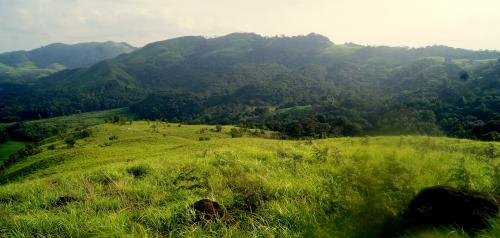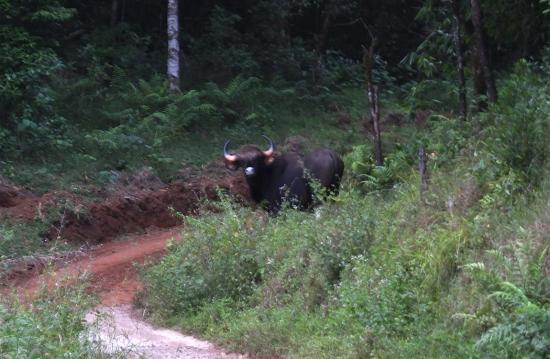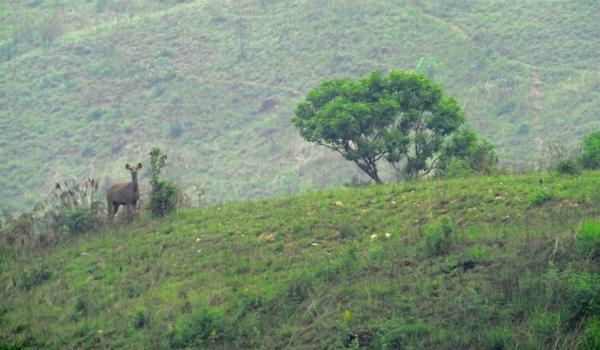
Part 1: First impressions
For my PhD research, I chose to come and work in a tea estate. Situated in the high rainfall forested hills of the Western Ghats of south-west India, it’s a fairly large holding, big enough to have been deemed a company unto itself by the owning corporation. You might ask, why has an ecologist come to a tea estate? What could possibly be ecological within a monoculture expanse of a boring bush, pruned obsessively to ensure our daily cup of plant secondary compounds?
The matrix: tea and forest
Well, as chance and good luck might have it, this large estate isn’t all tea. Compared to many other holdings of a similar nature and use, this property has a reasonable amount of forest cover left within its 3028 ha. More by chance perhaps than design, the cultivated areas are interspersed with remnant forests—ecologically termed fragments—and there are a couple of largish patches of about 100-150 ha. This is in spite of a rather flagrant history of heavy logging for timber and clear-felling of the forested hills to make charcoal from the wood. Story goes that the money from charcoal sales was used to pay off the costs of purchasing the land from the British.
I am an evergreen forest person. Having worked in some beautiful stretches of contiguous evergreen rainforests such as Silent Valley and Kudremukha National Parks (also in the Western Ghats), these little fragments don’t compare in splendor. But, aesthetics apart, we live in the reality of a largely human-dominated world. In heavily populated countries like India with a long history of agriculture and current trends of rampant economic development, Protected Areas alone will not suffice to save biodiversity.
In such hyper-populated countries, National Parks and Wildlife Sanctuaries are becoming isolated islands within a sea of human land-uses. Unless the parks themselves are extremely large (of the order of thousands of sq.km.) the plants and animals within could end up as isolated and unviable populations. Creating newer Protected Areas (PA) is becoming an increasingly difficult social prospect. The alternative is to create friendly spaces outside PA for wildlife to move through or use additionally.
When allowed, animals and plants move, colonize, and survive outside of human-drawn boundaries. The landscape of which Kadamane estate is a part falls along a potential corridor connecting Pushpagiri Wildlife Sanctuary in the south to Kudremukha National Park to its north. Largely a coffee-growing locale, there are forest patches of various sizes, some large Reserved Forests structurally link these two PA. But, other than natural history reports of elephants moving through and wildlife sightings here and there, no systematic study has assessed how plant and animal communities fare in the matrix.

Biodiversity in the landscape matrix
Landscapes such as where I work now, human-dominated agricultural areas that also have patches of forest interspersed, are known as multiple-use landscapes. These kind of areas are going to be increasingly important in retaining larger amounts of biodiversity than would be possible with PA alone. Further, such remnant forests often provide important ecosystem services for humans—preserving water catchments, regulating local climate, providing pollination services for crops, and protecting against soil erosion. As is the fashion now, the carbon holding capacity and soil nutrient regulation by forest fragments should also perhaps be mentioned here.
From a conservationist’s perspective, this poses promise for biodiversity. First however, we need to understand which species or specific groups of species appear to be using or surviving in such spaces. For example, a colleague of mine undertaking his research here is an avid birdwatcher, and has already documented 115 species. There has been a good flush of migrants coming here, and we have seen some fairly good sightings—Ceylon frogmouth, Rusty-tailed flycatcher, and Brown-breasted flycatcher. We have also been seeing quite a few species of frogs and snakes (herptiles) and butterflies around.
Those fond of large mammals will not be disappointed here either. There are Gaur, Sambar deer, Muntjac, and Mouse deer. Small carnivores like the Leopard cat, Brown mongoose, Brown palm civet, and the endangered Nilgiri Marten have been spotted. Elephants move through all the time, leaving tell-tale sights and smells and sometimes even visiting kitchen gardens.
While we haven’t quantified numbers to compare with larger forests, natural history observations would lend us to believe that some kinds of biodiversity are holding on fairly well and able to use these spaces. What we now need to know is how much of human-modified areas are being used when viewed at the scale of large landscapes, the frequency with which different areas are used by these animals and what determines this frequency, and whether these patterns of use remain stable over the long-term. The patterns of how animal and plant communities are structured in matrix landscapes (in different land-uses) makes for interesting research that could help manage these landscapes for their biodiversity.
Not all is well though…
However, private forests such as where I am now also have serious conservation issues. The major streams within the estate are being dammed to divert water for faraway cities as us city folks appear to have sucked up all the water where we live. For this purpose, roads within the estate are being widened to lay and transport pipelines and other equipment and for future maintenance of the same. The pipeline will bring down more than 1500 trees, cutting through one of the largest remaining forest patches that serves as a corridor and refuge for wildlife large and small. Even without any overt forest loss, road widening and all the disturbance due to construction has further fragmented forest patches creating hard edges where the vegetation and canopy had managed to grow back.
More insidious but pervasive problems additionally exist. Frequent signs of poachers suggest that illegal hunting is widespread here. There are also anecdotal reports of resident folks snaring or using dogs to catch small prey such as jungle fowl, monitor lizards, and mouse deer. Although current laws prevent cutting any trees for fuel or timber, trees are nonetheless cut away and I often see tell-tale stumps of young trees. Further, any fallen tree is immediately removed to use as firewood for use in homes, for drying tea leaves, or to make charcoal. This means that very little of the biomass is allowed to go back to the forest with consequences for carbon storage, soil nutrient cycles and ecosystem properties. 30 tons of firewood is used by this factory per day for drying tea, the demand intensifying during the wet monsoon months. Add to it all the water and electricity that goes into curing and packaging leaves. Now that’s something to think about while sipping the next cup of tea.
Outside the estate, streams are being dammed for micro-hydro projects. Albeit sold and promoted as “green energy”, they damage the region’s hydrology and compromise watershed services. A National Highway is all set for expansion, bringing down more forest. Illegal logging is not unknown, although thankfully not at the scales witnessed in the Amazon or South-east Asia. On the positive side, abandonment of plantation agriculture in some quarters is allowing forests to regenerate. This rural land is being bought up by urban dwellers and only time will tell what these land-use trends hold for conservation.
Living the field life
Nagging problems aside, life here is rather good for an ecologist. You wake up in the morning to the sound of birdcalls and get to see a fair number of species as you walk around. You will surely spot the occasional herd of gaur and sambhar. On night walks we have seen slender lorises and flying squirrels. Leopard cats visit chicken coops at night. Lucky folks even spotted the rare, endemic, and endangered Nilgiri Marten—I had a superb sighting of two martens. Bonnet monkeys here still behave like forest primates and are not stealing food from homes. Giant squirrels hang around in most places, dropping half-nibbled fruits in sudden fright when you pass underneath. King cobras, that most majestic of snakes, have been spotted frequently and Malabar pit vipers in hues of brown, green, and yellow are seen ever-so-often.
There is a curious pleasure in sharing the land with so many creatures, in watching the seasons turn, the trees flower and fruit, the migrants come and go. Slowly, you build a sense of connection to the rhythms of the world around. While the poetry is most enjoyable, the reality of changing landscapes however, keeps rudely reminding me that much might be lost too soon unless we realize the ecological consequences of our actions as individuals and a collective.
